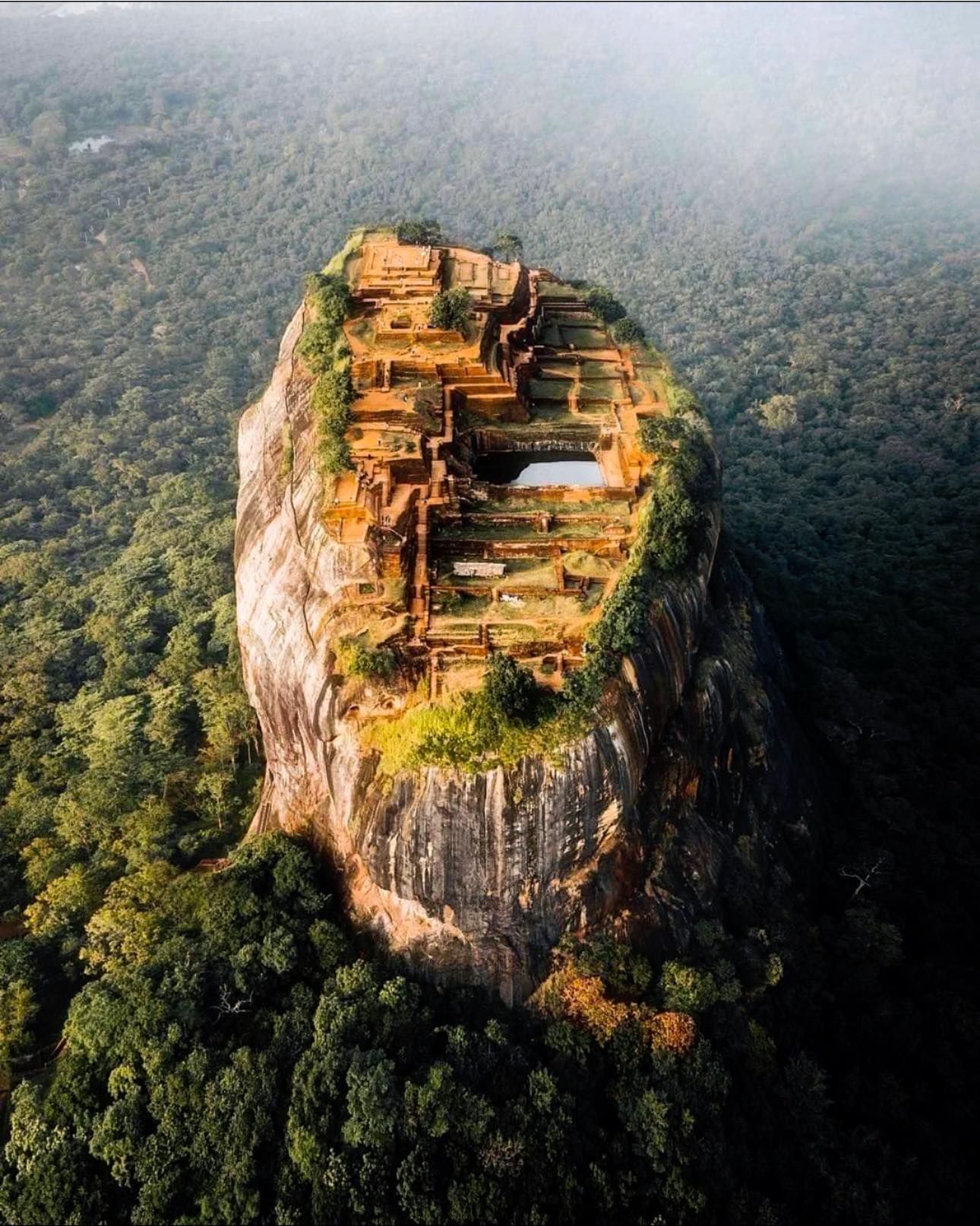
In the heart of Sri Lanka, where the jungle hums with cicadas and the canopy breathes in slow, leafy rhythms, a single rock rises like a question aimed at the sky. Its flanks are sheer and streaked with centuries of rain; its summit, strangely level, holds the forgotten footprint of a vanished world. This is Sigiriya—Lion Rock—the throne of a king who ruled from the clouds.
At first glance, it seems improbable. How could a palace exist atop a monolith? But step closer, and the mystery deepens. Staircases spiral where claws once guarded. Terraces cascade like earthen steps toward the sun. Pools shimmer where kings once saw their reflections drift between clouds. This is no ordinary ruin—it is ambition etched into stone.
The story begins with betrayal.
Kashyapa was not born to rule. His mother was a concubine, not a queen. But he was clever, and his ambition burned bright. In 477 AD, he seized the throne from his father, King Dhatusena, not with honor—but with blood. According to ancient chronicles, Kashyapa imprisoned his father and, when the loyalists refused to yield the kingdom, entombed him alive in a wall. The rightful heir, Moggallana, fled to India in exile. Kashyapa, now king but haunted by guilt and the threat of revenge, sought not just a palace—but a fortress that could never be stormed.
And so he turned to the rock.
It rose 200 meters above the jungle like a natural citadel. Its base was surrounded by moats and gardens, symmetrical in a way that seems almost impossibly modern. Hydraulic systems channeled water through pleasure gardens and cooling fountains—proof of engineering that rivaled the Roman world. Midway up the rock, he carved a gate shaped like a lion’s body, its paws flanking a narrow stairway. Through the lion’s mouth, you entered the sky.
This is why it’s called Sigiriya—from Sīnhāgiri, “Lion Rock.”
At the summit, Kashyapa built his palace, complete with mirror-polished walls so smooth they reflected the royal procession. Centuries later, monks would scrawl poetry onto them—verses of longing, beauty, and the women who once graced the galleries above. These frescoes still survive: ethereal figures with almond eyes and lotus hands, half in this world, half in the divine.
But a fortress is not always a refuge. For eighteen years, Kashyapa ruled from his sky-throne, watching the forest like a hawk. His kingdom was stable, his roads paved, his gardens blooming. Yet every sunrise reminded him of Moggallana—his brother, his ghost, his shadow. When Moggallana finally returned at the head of an army, Kashyapa descended from his stronghold to meet him. Legend says he misjudged a swamp and became stranded. His troops fled. Rather than face defeat, he drew his own dagger across his throat.
The Lion Rock fell silent.
In the centuries that followed, Sigiriya transformed. Monks moved in, turning the royal chambers into meditative cells. Pilgrims carved graffiti in ancient scripts along the stairwells. Jungle vines wrapped around stone balustrades, claiming each ruin like a returning tide. The lion’s head collapsed in time, leaving only the giant paws. Rain filled the pools, frogs nested in the gardens. The palace turned into legend.
But the bones of Kashyapa’s dream remained.
Today, the site is a UNESCO World Heritage treasure—a fusion of palace, fortress, and monastery. Archaeologists have uncovered everything from Buddhist manuscripts to grinding stones, from fresco pigments to royal inscriptions. The hydraulic system still functions in parts. The engineering, precision-cut through solid rock, continues to inspire wonder.
And still, it feels haunted.
Perhaps it’s the solitude. Standing atop the rock at dawn, with mist curling across the jungle like a breath held too long, it’s easy to imagine Kashyapa stepping barefoot across the stones, listening to the forest below. He ruled alone, feared and unloved. He built his kingdom to escape fate—and met it anyway. There’s something deeply human in that.
The site challenges our ideas of what ancient power looked like. It wasn’t always about gold or marble. Sometimes, it was about escape. About carving a kingdom out of fear and calling it paradise. About building so high, no one could reach you—not even your past.
When you visit, there’s a moment just before the summit where you pᴀss through the Lion Gate. The paws, still mᴀssive, still watchful, frame the climb like an initiation. The stairs wind steeply, cut directly into the face of the cliff. The wind whistles here. Birds cry out from impossible heights. And then you rise above it all.
You reach the top, and the ruins spread out like a broken mosaic—red stone, grᴀssy courtyards, water tanks reflecting the sky. You feel the isolation. But also the clarity. The vast forest stretches in every direction, its green canopy unbroken except by this one defiant spike.
Sigiriya is more than a ruin. It is a story about power and paranoia, beauty and loss. About a king who tried to outrun the weight of blood and history, and in doing so, created something that would outlast both.
What would you build, if you had to hide from the world—yet still wanted it to remember you?


